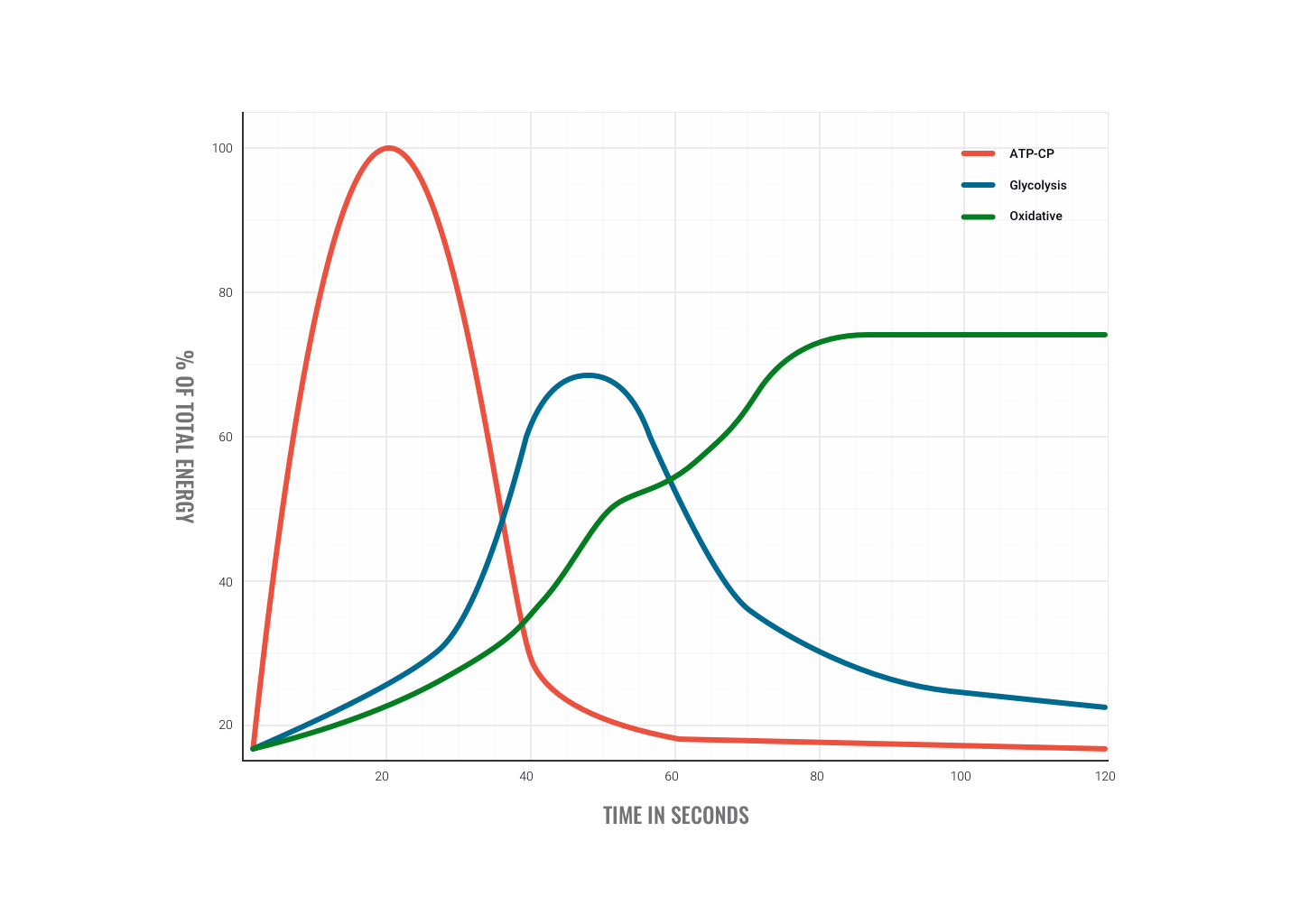Understanding energy systems is important for personal trainers as this knowledge underpins our knowledge of how the human body works and relates to exercise principles.
Energy systems directly relate to programme design. Understanding the mode and utilisation of "energy in" can help you best review and observe the chronic and acute responses to training stimuli. Energy systems dictate the reasoning behind rest periods in between sets, frequency, breathing, and hypertrophic responses. It's all connected, and energy systems connect anatomical function, programme design, and training adaptations.
Before we learn about energy systems, let’s define what is meant by fitness, fatigue, and fuel. These concepts will help you understand why each energy system is important to your work as a personal trainer.
In this topic we will cover:
- An overview of the energy systems
- A detailed look at each system
- How the body burns fat
- Methods to train the energy systems/li>
Fitness, fatigue, and fuel
In simple terms, muscle fatigue often occurs after strenuous exercise (or other activities) and causes an individual to feel weak. It is a symptom that reduces the ability of the muscles to perform over time.
- Fitness is the ability to make enough energy to meet demands being placed on the body.
- Fatigue is the inability of the muscles to meet energy requirements being placed on the body and a decrease in the ability to produce force because of, or after, prolonged activity.
Adenosine triphosphate (ATP) is the key fuel and is common to all movement production. We must transfer the energy from food into a more high-energy compound that our bodies can use to produce movement. ATP captures chemical energy from the breakdown of food and releases the energy to other cellular processes.
Energy systems provide the energy required for muscles to move. They extract the energy from the foods we eat and turn it into chemical energy our bodies can use. 3 energy systems work together to ensure enough ATP for all our daily activities:
- ATP-PC system
- Glycolysis system
- Oxidative system
Each system produces ATP from different sources and at different speeds.
| System | Description |
|---|---|
| ATP-PC | Anaerobic - does not need oxygen (02) |
| Glycolysis | Anaerobic - does not need oxygen (02) |
| Oxidative | Aerobic – needs oxygen (02) |
The ATP-PC and glycolysis systems are both anaerobic systems. This means that oxygen is not used by these systems to synthesise ATP.
These systems are quick at producing energy, however, they don't last very long. They fatigue quickly because they do not call on oxygen as fuel. From an exercise perspective, it is optimal to use aerobic energy production for as long as possible to avoid fatigue and enhance fat burn.

These energy systems also go by other common names. When you review other literature and readings, you can use the terms interchangeably.
| System | Alternative name(s) |
|---|---|
| ATP-PC | Phosphagen, phosphocreatine, alactic |
| Glycolysis | Anaerobic glycolytic system, lactic acid system |
| Oxidative | Aerobic system |
Energy systems and fitness components
The following illustration shows the connection between energy systems and fitness components.

Watch
The following video discusses energy systems in more detail from the perspective of a fitness trainer.
Why do you need to know energy systems?
The main reason it is essential for you to have a working knowledge of energy systems is to ensure your programmes are set up to provide correct intensities, durations, rest periods, and training types specific to the sport or activity you are training. Your client's capacity to train depends on their ability to supply their muscles with enough ATP. Improving these systems is very specific to the training you do.
Adenosine triphosphate (ATP)
ATP is the body's energy currency. It comprises an adenosine molecule and three phosphate groups. The bonds holding the phosphates together (represented in the following illustration in red) are very high in energy.
When these bonds are split by an enzyme, a large amount of energy is released which can be harnessed for processes like muscle contraction. When the bond is broken, ATP becomes ADP (adenosine diphosphate).
You only have about 3 seconds worth of ATP stored in the body.
Exercise intensity and duration
Each system provides ATP at different levels of exercise intensity and duration. The systems are ordered from the highest intensity (ATP-PC) to the lowest intensity (Oxidative).
There are 2 anaerobic systems and 1 aerobic energy system. So, what do anaerobic and aerobic mean?
- Anaerobic means oxygen (supplied by our cardiovascular system) is not required for this system to function at full capacity. Anaerobic systems are relied on in the first seconds of intense exercise where there is insufficient oxygen.
- Aerobic means 'with oxygen' and refers to using oxygen in the muscle's energy-generating process. This generally means exercise is of lower intensity and has the capacity to supply large amounts of ATP relatively slowly.
Energy systems can be daunting, particularly if you aren't fond of chemistry. The following tables summarise the 3 energy systems.
Table 1: Energy systems, activity, and ATP produced
| Energy system | Activity | ATP produced |
|---|---|---|
| ATP-PCr | Very high intensity, short duration (6-10 seconds) without the use of oxygen (i.e. anaerobic); active at the onset of all activity | 1 |
| Anaerobic glycolysis | High intensity, short-to-moderate duration (10-90 seconds) without the use of oxygen | 2 |
| Oxidative phosphorylation (aerobic) | Low-to-moderate intensity, long duration (>90 seconds) | Carbohydrates 36-39 |
Table 2: Speed of ATP produced by each system
| Fuel and system | Relative speed of ATP production |
|---|---|
| Phosphocreatine (ATP-PC) | 100 |
| Glucose (anaerobic glycolysis) | 55 |
| Glucose (aerobic glycolysis) | 23 |
| Fats | 10 |
Table 3: Intensity, duration, fuel, by-products, and recovery by energy system
| ATP-PC | Glycolysis | Oxidative | |
|---|---|---|---|
| Intensity | Very hard | Hard | Light to moderate |
| Duration | <10 seconds | Up to 90 seconds to 2 minutes | Up to several hours, as long as there is enough fuel |
| Fuel | PCr | Glucose | Glucose, fat, protein |
| By-products | None | Lactic acid | C02, H20, heat |
| Recovery | 3-5 minutes | As long as it takes to remove lactic acid |
Check that you have a good grasp of energy systems before attempting the muscular system and energy systems test.
